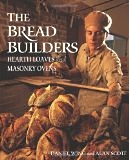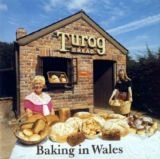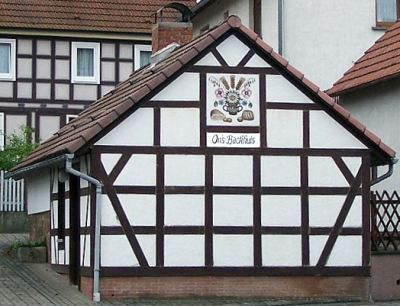-
History of:
- Resources about:
- More:
- Baby walkers
- Bakehouses
- Bed warmers
- Beer, ale mullers
- Besoms, broom-making
- Box, cabinet, and press beds
- Butter crocks, coolers
- Candle snuffers, tallow
- Clothes horses, airers
- Cooking on a peat fire
- Drying grounds
- Enamel cookware
- Fireplaces
- Irons for frills & ruffles
- Knitting sheaths, belts
- Laundry starch
- Log cabin beds
- Lye and chamber-lye
- Mangles
- Marseilles quilts
- Medieval beds
- Rag rugs
- Rushlights, dips & nips
- Straw mattresses
- Sugar cutters - nips & tongs
- Tablecloths
- Tinderboxes
- Washing bats and beetles
- Washing dollies
- List of all articles
Subscribe to RSS feed or get email updates.
Carrying the dough from the home to the bakehouse was a delicate task. Having risen in the warmth of the hearth, it would have to be covered with a flannel or thick cloth and carried quickly as the cold air would check its rising.
Sarah Tibbott, Baking in Wales

The Bread Builders: Hearth Loaves and Masonry Ovens, by Wing and Scott, from Amazon.comor Amazon UK

Sarah Tibbott, Baking in Wales, from Amazon.comor Amazon UK

Bakehouses and community bread ovens
Communal ovens and shared spaces for baking
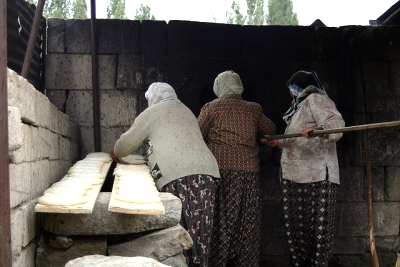 Baking bread or pizza
in your own wood-fired stone or brick oven is a newly discovered pleasure for enthusiasts
in the western world, but it's routine for people in some countries. If they don't
have an oven at home, they take their homemade dough to communal ovens or bakehouses,
often following the tradition of centuries. The Turkish women in the photo are making
flatbreads which they will carry home on a plank of wood, leaving the oven and long-handled
bread peel available for the next users.
Baking bread or pizza
in your own wood-fired stone or brick oven is a newly discovered pleasure for enthusiasts
in the western world, but it's routine for people in some countries. If they don't
have an oven at home, they take their homemade dough to communal ovens or bakehouses,
often following the tradition of centuries. The Turkish women in the photo are making
flatbreads which they will carry home on a plank of wood, leaving the oven and long-handled
bread peel available for the next users.
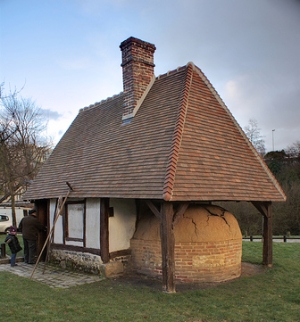 Sharing in a community oven was
common in Europe for centuries. It's still widespread in the Middle East and North
Africa, but died out in most of western Europe in the 20th century. You can share
equally, maybe drawing lots for your turn in a village bakehouse, or pay a small
fee to a professional baker to put your loaves into his oven. And you aren't limited
to bread. Greek bakehouses still cook Easter lamb dishes for villagers. This was
once quite common in England and other countries too. Meat, pies, cakes, and other
dishes for festivals and holy days used to be cooked in big bread ovens by families
who normally cooked on the hearth, but could
afford a few extra pennies for special meals.
Sharing in a community oven was
common in Europe for centuries. It's still widespread in the Middle East and North
Africa, but died out in most of western Europe in the 20th century. You can share
equally, maybe drawing lots for your turn in a village bakehouse, or pay a small
fee to a professional baker to put your loaves into his oven. And you aren't limited
to bread. Greek bakehouses still cook Easter lamb dishes for villagers. This was
once quite common in England and other countries too. Meat, pies, cakes, and other
dishes for festivals and holy days used to be cooked in big bread ovens by families
who normally cooked on the hearth, but could
afford a few extra pennies for special meals.
[In late 19th century Northamptonshire, England] people would bring along their Sunday joints on the way to church; the joints, on trays complete with the housewife's own batter puddings and potatoes for roasting, would be popped into the baker's ovens and churchgoers would collect their sizzling hunks of meat after church to carry them home again under a cloth.
Valerie Porter, Yesterday's Countryside: Country Life as it Really Was
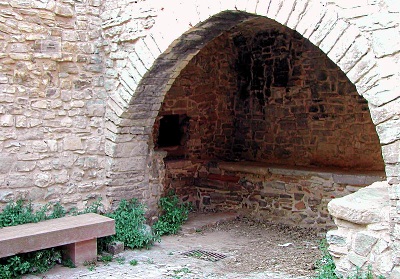 Conservation work is going on at old, crumbling bakehouses in Germany,
Belgium, France and elsewhere. They may be restored to full functioning
with baking days and bakery sales, or preserved by conversion into holiday cottages
or other private buildings.
Conservation work is going on at old, crumbling bakehouses in Germany,
Belgium, France and elsewhere. They may be restored to full functioning
with baking days and bakery sales, or preserved by conversion into holiday cottages
or other private buildings.
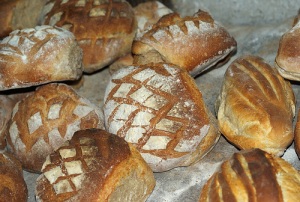 Even when no-one local remembers
actually baking in the old unrestored oven, there may be memories of the importance
of the bakehouse in village life. Often they were a focal point for the community,
with a central location. The bakehouse could be a place for women to socialise and
exchange news. In places where a baker presided over the oven, it might be young
people and children who got a chance to meet while handing in dough and picking
up loaves. Pans of dough were marked with distinctive cuts or with metal "tallies"
to make sure you got your own bread after baking.
Even when no-one local remembers
actually baking in the old unrestored oven, there may be memories of the importance
of the bakehouse in village life. Often they were a focal point for the community,
with a central location. The bakehouse could be a place for women to socialise and
exchange news. In places where a baker presided over the oven, it might be young
people and children who got a chance to meet while handing in dough and picking
up loaves. Pans of dough were marked with distinctive cuts or with metal "tallies"
to make sure you got your own bread after baking.
All the households in the village drew lots once a week for their baking time in the bake house and brought their bread dough, made at home, in big wooden tubs.
Anna E. Altmann, The Seven Swabians, and Other German Folktales(from the factual introduction)
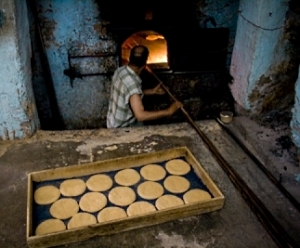 In France many rural
bakehouses were used well into the 20th century but their origins were in medieval
times. Peasants then had no choice but to bake in the feudal lord's designated oven
after having their grain ground into flour by the seigneur's (master's) miller,
and to pay the relevant charges. The French name "four banal" reflects this.
The banal or bannal laws were the regulations that kept flour and grain under the
control of the feudal superior. Medieval England and other parts of Europe also
had "bannal mills" and "bannal ovens". Early French settlers in Canada started out
with similar laws, but they didn't last - not least because a long cold trip from
a frontier homestead to the nearest public oven tends to kill off the yeast in rising
dough. There were some shared bake ovens in early New England settlements but the concept
didn't spread through North America.
In France many rural
bakehouses were used well into the 20th century but their origins were in medieval
times. Peasants then had no choice but to bake in the feudal lord's designated oven
after having their grain ground into flour by the seigneur's (master's) miller,
and to pay the relevant charges. The French name "four banal" reflects this.
The banal or bannal laws were the regulations that kept flour and grain under the
control of the feudal superior. Medieval England and other parts of Europe also
had "bannal mills" and "bannal ovens". Early French settlers in Canada started out
with similar laws, but they didn't last - not least because a long cold trip from
a frontier homestead to the nearest public oven tends to kill off the yeast in rising
dough. There were some shared bake ovens in early New England settlements but the concept
didn't spread through North America.
21st century Switzerland: The people of Salouf, near Savognin, still bake their bread in a communal bakehouse of this kind. It is directly on the main village square, never noticed by tourists, and forms part of the village community's public life.
Petra Hagen, The Architect, the Cook and Good Taste
Other pages about baking:
Bread peels, bakers' paddles
Flat breads and bannocks baked on the hearth
Also see:
Dough boxes, bins, kneading troughs
The good old squire hobbles out of church, leaning on the arm of his daughter, and kindly inquires after the welfare of all about him. He sends food and money to the sick and needy, makes up quarrels as a magistrate, maintains a well-ordered Sunday-school, and promotes the happiness of the villagers by every means in his power. If, on returning from church, he meets a smoking dinner going to a cottage from the village bake-house, he generally slips a shilling into the hand of the bearer, for the purpose, as he says, of washing the dinner down with a little good ale.
Edward Jesse, The English Village, from Gleanings in Natural History, 1832
 18 Jan 2011
18 Jan 2011
You may like our new sister site Home Things Past where you'll find articles about antiques, vintage kitchen stuff, crafts, and other things to do with home life in the past. There's space for comments and discussion too. Please do take a look and add your thoughts. (Comments don't appear instantly.)
For sources please refer to the books page, and/or the excerpts quoted on the pages of this website, and note that many links lead to museum sites. Feel free to ask if you're looking for a specific reference - feedback is always welcome anyway. Unfortunately, it's not possible to help you with queries about prices or valuation.


